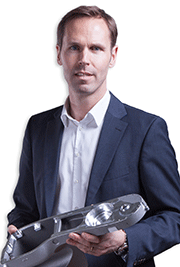E-Archive
MFN Trainer Column
in Vol. 19 - July Issue - Year 2018
A Technology Looking For Applications

Markus Halder
It is hard to believe that it is 13 years since I was asked whether I would like to be a member of the MFN Trainer Team, to support the MFN team, and continue to make shot peening technology better known and pass the know-how on to interested parties. Needless to say, it was a great honour for me to take an active part in the circle of highly-qualified, experienced experts in this field. Thanks to the use of this production-orientated process in such high-end sectors as motor sports, armaments, railway construction and aviation, experience increases with every new project.
Only a few operating sites allow the use of lightweight materials or composites, such as carbon fibre for instance. Production costs here still lie in an area that is not made financially viable by the market or where the use of these materials does not make sense from a technical point of view. In my opinion therefore, the use of steel, aluminium or titanium alloys as a construction material still has a long-term role to play. As a rule, the aim is saving on both material and component weights, whilst simultaneously satisfying ever-increasing requirements. The significance of shot peening technology is particularly clear here, whilst the development of new applications in the field of component surfaces represents a great challenge. The components are analysed and the optimal process parameters developed. The improvements achieved are verified by testing the fatigue strength and long-term durability using custom-designed test rigs.
The saving of weight by using lightweight materials is noticeable not only where production costs are concerned. Also particularly great are the energy savings when operating road vehicles, railway trains or in the aviation industry, because of the mass that is being moved. Means of transport are becoming more and more automated and packed full of electronics and functions that improve convenience, so that additional weight is built in as a result. Nowadays, a medium class car already has up to 70 kg of cable harnesses integrated into it. Furthermore, the dimensions of automobiles have continually been increased for reasons of comfort, which also increases the weight considerably. Only in the application of recuperation with a high energy recovery percentage does additional vehicle weight play a secondary role. The automotive industry is frequently a trailblazer when it comes to the application of new, more cost-effective manufacturing processes. Ultimately in the case of components for automobile construction, it is basically a question of low-cost products. A manufacturing process involving shot peening has established itself in all systems: power train, chassis parts, steering and much more besides. However, the process with all its benefits has not yet become accepted comprehensively in other sectors of industry, such as machine construction. Yet again here, the use of shot peening amongst other things can offer competitive advantages!
The cause can be found in component design. The design engineer only specifies technologies on manufacturing drawings with which he is sufficiently familiar. When designing components that will be subjected to mechanical stress, most strains calculated are aligned with the maximum permissible ones and, if necessary, a safety factor specific to the application is also considered. Component optimisation, by using shot peening for instance, rarely finds an application during these calculations. In the field of transmission design or comparable, standardised design tasks, empirical values help to take into account the positive influence of shot peening on the design. It is frequently criteria relevant to liability that stop the integration of achievable improvements during component design, as the process is not sufficiently standardised nor is recognised as being state-of-the-art.
Shot peening is frequently used as the last straw, if the components used in the operation unexpectedly fail at an early stage. It is then vital to react quickly, because many assemblies are in use and the level of uncertainty is high. How many components could be affected? What is the cause of the component failure? How is it possible to react in the short term, but without endangering security of supply?
A solution could be the universal integration of this technology in standardisation and teaching. Sufficient research results have been generated in the last few decades. It could now be important to forge a link between the standards of component design, taking in process specifications and standards along the way until a method of process supervision is created, which will serve as an adequate basis for education and will improve the way in which the decision-makers handle things.
For questions contact markus@mfn.li
Author: Markus Halder



























